Apps
Auto Added by WPeMatico
Auto Added by WPeMatico
The underpinnings of how app store analytics platforms operate were exposed this week by BuzzFeed, which uncovered the network of mobile apps used by popular analytics firm Sensor Tower to amass app data. The company had operated at least 20 apps, including VPNs and ad blockers, whose main purpose was to collect app usage data from end users in order to make estimations about app trends and revenues. Unfortunately, these sorts of data collection apps are not new — nor unique to Sensor Tower’s operation.
Sensor Tower was found to operate apps such as Luna VPN, for example, as well as Free and Unlimited VPN, Mobile Data and Adblock Focus, among others. After BuzzFeed reached out, Apple removed Adblock Focus and Google removed Mobile Data. Others are still being investigated, the report said.

Apps’ collection of usage data has been an ongoing issue across the app stores.
Facebook and Google have both operated such apps, not always transparently, and Sensor Tower’s key rival App Annie continues to do the same today.
For Facebook, its 2013 acquisition of VPN app maker Onavo for years served as a competitive advantage. The traffic through the app gave Facebook insight into which other social applications were growing in popularity — so Facebook could either clone their features or acquire them outright. When Apple finally booted Onavo from the App Store half a decade later, Facebook simply brought back the same code in a new wrapper — then called the Facebook Research app. This time, it was a bit more transparent about its data collection, as the Research app was actually paying for the data.
But Apple kicked out that app, too. So Facebook last year launched Study and Viewpoints to further its market research and data collection efforts. These apps are still live today.
Google was also caught doing something similar by way of its Screenwise Meter app, which invited users 18 and up (or 13 if part of a family group) to download the app and participate in the panel. The app’s users allowed Google to collect their app and web usage in exchange for gift cards. But like Facebook, Google’s app used Apple’s Enterprise Certificate program to work — a violation of Apple policy that saw the app removed, again following media coverage. Screenwise Meter returned to the App Store last year and continues to track app usage, among other things, with panelists’ consent.
App Annie
App Annie, a firm that directly competes with Sensor Tower, has acquired mobile data companies and now operates its own set of apps to track app usage under those brands.
In 2014, App Annie bought Distimo, and as of 2016 has run Phone Guardian, a “secure Wi-Fi and VPN” app, under the Distimo brand.
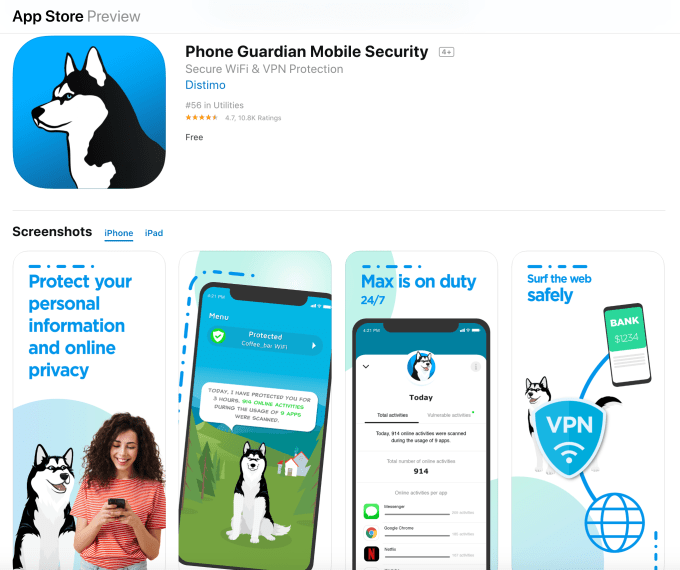
The app discloses its relationship with App Annie in its App Store description, but remains vague about its true purpose:
“Trusted by more than 1 million users, App Annie is the leading global provider of mobile performance estimates. In short, we help app developers build better apps. We build our mobile performance estimates by learning how people use their devices. We do this with the help of this app.”
In 2015, App Annie acquired Mobidia. Since 2017, it has operated real-time data usage monitor My Data Manager under that brand, as well. The App Store description only offers the same vague disclosure, which means users aren’t likely aware of what they’re agreeing to.
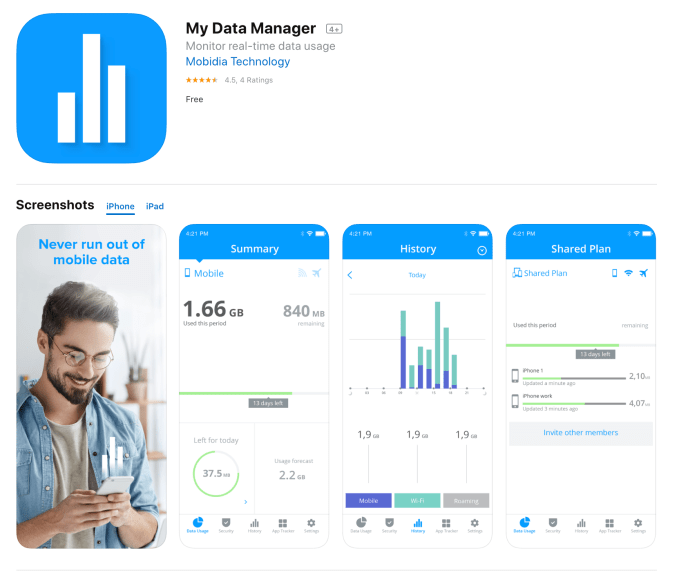
Disclosure?
The problem with apps like App Annie’s and Sensor Tower’s is that they’re marketed as offering a particular function, when their real purpose for existing is entirely another.
The app companies’ defense is that they do disclose and require consent during onboarding. For example, Sensor Tower apps explicitly tell users what is collected and what is not:

App Annie’s app offers a similar disclosure, and takes the extra step of identifying the parent company by name:
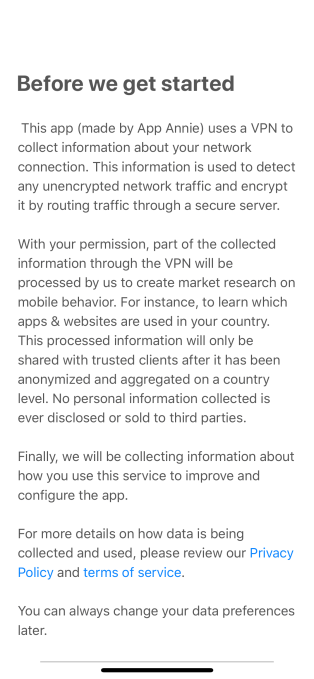
App Annie also says its apps can continue to be used even if data sharing is turned off.
Despite these opt-ins, end users may still not understand that their VPN app is actually tied to a much larger data collection operation, however anonymized that data may be. After all, App Annie and Sensor Tower aren’t household names (unless you’re an app publisher or marketer.)
Apple and Google’s responsibility
Apple and Google, let’s be fair, are also culpable here.
Of course, Google is more pro-data collection because of the nature of its own business as an advertising-powered company. (It even tracks users in the real world via the Google Maps app.)
Apple, meanwhile, markets itself as a privacy-focused company, so is deserving of increased scrutiny.
It seems unfathomable that, following the Onavo scandal, Apple wouldn’t have taken a closer look into the VPN app category to ensure its apps were compliant with its rules and transparent about the nature of their businesses. In particular, it seems Apple would have paid close attention to apps operated by companies in the app store intelligence business, like App Annie and its subsidiaries.
Apple is surely aware of how these companies acquire data — it’s common industry knowledge. Plus, App Annie’s acquisitions were publicly disclosed.
oh wait! pic.twitter.com/ktVc6E9t1f
— Will Strafach (@chronic) March 10, 2020
But Apple is conflicted. It wants to protect app usage and user data (and be known for protecting such data) by not providing any broader app store metrics of its own. However, it also knows that app publishers need such data to operate competitively on the App Store. So instead of being proactive about sweeping the App Store for data collection utilities, it remains reactive by pulling select apps when the media puts them on blast, as BuzzFeed’s report has since done. That allows Apple to maintain a veil of innocence.
But pulling user data directly covertly is only one way to operate. As Facebook and Google have since realized, it’s easier to run these sorts of operations on the App Store if the apps just say, basically, “this is a data collection app,” and/or offer payment for participation — as do many marketing research panels. This is a more transparent relationship from a consumer’s perspective too, as they know they’re agreeing to sell their data.
Meanwhile, Sensor Tower and App Annie competitor Apptopia says it tested then scrapped its own ad blocker app around six years ago, but claims it never collected data with it. It now favors getting its data directly from its app developer customers.
“We can confidently state that 100% of the proprietary data we collect is from shared App Analytics Accounts where app developers proactively and explicitly share their data with us, and give us the right to use it for modeling,” stated Apptopia co-founder and COO, Jonathan Kay. “We do not collect any data from mobile panels, third-party apps or even at the user/device level.”
This system (which is used by the others as well) isn’t necessarily a solution for end users concerned about data collection, as it further obscures the collection and sharing process. Generally, consumers don’t know which app developers are sharing this data, what data is being shared, or how it’s being utilized. App data of this nature isn’t on the user level (meaning it’s not personal data), but it’s still about reporting back to the developer things like installs, daily and monthly users, and revenue, among other things. (Fortunately, Apple allows users to disable the sharing of some diagnostic and usage data from within iOS Settings.)
Data collection done by app analytics firms is only one of many, many ways that apps leak data, however.
In fact, many apps collect personal data — including data that’s far more sensitive than anonymized app usage trends — by way of their included SDKs (software development kits). These tools allow apps to share data with numerous technology companies, including ad networks, data brokers and aggregators, both large and small. It’s not illegal, and mainstream users probably don’t know about this either.
Instead, user awareness seems to crop up through conspiracy theories, like “Facebook is listening through the microphone,” without realizing that Facebook collects so much data it doesn’t really need to do so. (Well, except when it does).
In the wake of BuzzFeed’s reporting, Sensor Tower says it’s “taking immediate steps to make Sensor Tower’s connection to our apps perfectly clear, and adding even more visibility around the data their users share with us.”
Google isn’t providing an official comment. Apple didn’t respond to requests for comment.
Sensor Tower’s full statement is below:
Our business model is predicated on high-level, macro app trends. As such, we do not collect or store any personally identifiable information (PII) about users on our servers or elsewhere. In fact, based on the way our apps are designed, such data is separated before we could possibly view or interact with it, and all we see are ad creatives being served to users. What we do store is extremely high level, aggregated advertising data that may demonstrate trends that we share with customers.
Our privacy policy follows best practices and makes our data use clear. We want to reiterate that our apps do not collect any PII, and therefore it cannot be shared with any other entity, Sensor Tower or otherwise. We’ve made this very clear in our privacy policy, which users actively opt into during the apps’ onboarding processes after being shown an unambiguous disclaimer detailing what data is shared with us. As a routine matter, and as our business evolves, we’ll always take a privacy-centric approach to new features to help ensure that any PII remains uncollected and is fully safeguarded.
Based on the feedback we’ve received, we’re taking immediate steps to make Sensor Tower’s connection to our apps perfectly clear, and adding even more visibility around the data their users share with us.
App Annie shared the below statement, referencing the root certificate installations mentioned in the BuzzFeed article. (On iOS devices, VPN certificates don’t get full root access, however):
App Annie does not use root certificates at any point in its data collection process.
App Annie discloses that when users opt into data collection (and data sharing is not mandatory to use our apps), data will be shared with App Annie for the purposes of creating market research. We only collect data after users expressly consent to this collection within our apps. We are very transparent, both on the app stores and in the apps themselves and clearly connect App Annie to our mobile apps.
Powered by WPeMatico
Two video startups are making dueling legal claims against the other.
The Wall Street Journal broke the news yesterday that interactive video company Eko is accusing Quibi of infringing on its patented technology.
At around the same time, The Hollywood Reporter noted that Quibi (which is launching its short-form mobile video service next month) has filed a complaint in California federal court claiming that Eko has engaged in “a campaign of threats and harassment.”
At the heart of the dispute is Quibi’s Turnstyle technology, which allows viewers to seamlessly switch between landscape and portrait-mode viewing.
Both companies seem to agree that Eko CEO Yoni Bloch met with Jeffrey Katzenberg in March 2017 (before Katzenberg had even founded Quibi) about a possible investment in Eko, and that there was at least one follow-up meeting between Quibi and Eko employees in 2019.
Eko claims that it provided Quibi employees — both while they were working at Quibi and before then, when they were previously at Snap — with details and code behind its technology. Then, after Katzenberg and Quibi CEO Meg Whitman showed off Turnstyle at CES this year, Eko sent a letter to Quibi claiming that the feature infringed on its intellectual property. (According to the Journal’s story, Eko’s lawyers have sent a letter to Quibi but have not filed a lawsuit.)
“Our Turnstyle technology was developed internally at Quibi by our talented engineers and we have, in fact, received a patent for it,” Quibi said in a statement. “These claims have absolutely no merit and we will vigorously defend ourselves against them in court.”
Meanwhile, in a statement, Eko described Quibi’s technology as “a near-identical copy of its own,” and said the company’s legal motion is “nothing more than a PR stunt”:
It is telling that Quibi filed the motion only after learning the Wall Street Journal was going to publish an article exposing allegations of Quibi’s theft of Eko’s technology … Eko will take the legal actions necessary to defend its intellectual property and looks forward to demonstrating its patent rights to the court.
You can read Quibi’s full complaint below.
Quibi complaint by TechCrunch on Scribd
Powered by WPeMatico
Credit Sesame is getting into digital banking. The credit and loans company, first launched at TechCrunch Disrupt in 2010, has since grown to 15 million registered users and, in 2016, achieved profitability. To date, its focus has been on helping consumers achieve financial health by taking steps to consolidate debt and raise their credit score. Now, it’s expanding to include digital banking, but with the goal of using its better understanding of its banking customers’ finances to better personalize its credit improvement recommendations.
The new service, Sesame Cash, has many features found in other challenger banking apps, like a general lack of fees, real-time notifications, an early payday option, free access to a sizable ATM network, in-app debit card management and more. Specifically, Credit Sesame says it won’t charge monthly fees or overdraft fees, and it provides free access to more than 55,000 ATMs and a no-fee debit card from Mastercard.
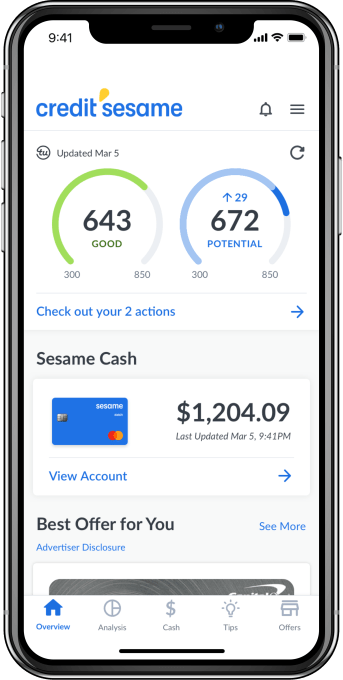 However, the banking app also serves a secondary purpose beyond its plan to take on traditional banks. Because the company has insights into users’ finances and repayment abilities, it will be able to offer personalized recommendations, including those for relevant credit products from its hundreds of financial institution partners.
However, the banking app also serves a secondary purpose beyond its plan to take on traditional banks. Because the company has insights into users’ finances and repayment abilities, it will be able to offer personalized recommendations, including those for relevant credit products from its hundreds of financial institution partners.
Other features also differentiate Sesame Cash from rival challenger banks, including built-in access to view your daily credit score and a system that rewards consumers with cash incentives — up to $100 per month — for credit score improvements. The banking app includes $1 million in credit and identity theft protection, as well.
In the months following its launch, the company is planning to introduce a smart bill pay service that manages cash to improve credit and lower interest rates on credit balances, plus an auto-savings feature that works by rounding up transactions, a rewards program for everyday purchases and other smart budgeting tools.
“Through the use of advanced machine learning and AI, we’ve helped millions of consumers improve and manage their credit. However, we identified the disconnect between consumers’ cash and credit—how much cash you have, and how and when you use your cash has an impact on your credit health,” said Adrian Nazari, Credit Sesame Founder and CEO, in a statement. “With Sesame Cash, we are now bridging that gap and unlocking a whole new set of benefits and capabilities in a new product category. This underscores our mission and commitment to innovation and financial inclusion, and the importance we place in working with partners who share the same ethos,” he added.
Credit Sesame today caters to consumers interested in bettering their credit. The company says 61% of its members see credit score improvements within their first six months, and 50% see scores improve by more than 10 points during that time. Indeed, 20% see their score improve by more than 50 points during the first six months.
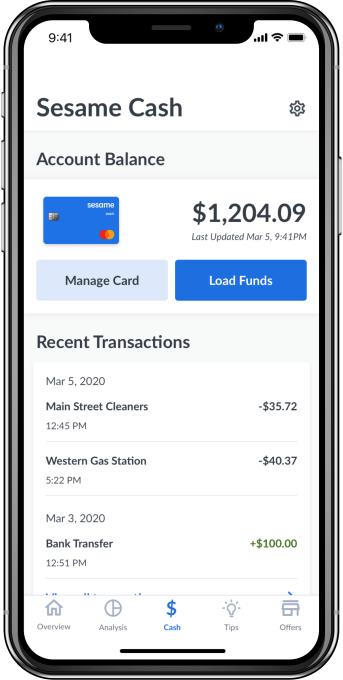 But one challenge Credit Sesame faces is that after consumers reach their goals, credit-wise, they may become less engaged with the Credit Sesame platform. The new banking app changes that, by allowing the company to maintain a relationship with customers over time.
But one challenge Credit Sesame faces is that after consumers reach their goals, credit-wise, they may become less engaged with the Credit Sesame platform. The new banking app changes that, by allowing the company to maintain a relationship with customers over time.
Credit Sesame is a smaller version of Credit Karma, which was recently acquired by Intuit for $7 billion. Since then, it has been rumored to be another potential acquisition target for Intuit, if it didn’t proceed to go public. The banking service would make Credit Sesame more attractive to a potential acquirer, if that’s the case, as it would offer something Credit Karma did not.
The company says Sesame Cash bank accounts are held with Community Federal Savings Bank, Member FDIC.
The banking service will initially be made available to existing customers, before becoming available to the general public. The Credit Sesame mobile app is a free download for iPhone and Android.
Powered by WPeMatico
No-code tools are on the rise, and a YC-backed company called Snapboard is looking to join the fight.
Snapboard, led by solo founder Calum Moore, started when Moore decided to build one product a week for a year as a personal challenge. In the second week, he realized just how many apps and services it took not only to build the product, but to post about it on social media.
He wanted a way to manage all those apps and tools from one dashboard. So he built Snapboard.
Snapboard allows users to link and manage a wide variety of apps and platforms in a single, customizable dashboard. Users can create boards that act as internal tools without getting the product or engineering team involved for an internal project. Moore describes it as “Airtable, but with all of your data already in there.”
More than 50 apps are available on the Snapboard platform, including Shopify, Dropbox, Google Analytics, MailChimp, MongoDB, MySQL, Trello, Zendesk and many more. Moore isn’t concerned with onboarding new integrated apps for Snapboard, as most of the popular tools used by startups and tech firms are API supported.
The use cases are innumerable, which is just as challenging as it is beneficial. Moore detailed a few examples, including building boards for each individual customer, combining Stripe data with emails sent through Mail Chimp to try to target behavior.
However, the flexibility of the platform means that it can do almost anything, but only if you know what you want to do with it. It can be difficult to evangelize for something that is so nebulous, and can be used so many ways.
Moore says the key is to sprint on building out the template library for Snapboard, offering new users a multitude of options as inspiration.
Snapboard offers a free tier, and then charges $10/month/seat for more advanced features. Thus far, the company has 3,000 registered users and around 230 WAUs.
The company is targeting tech companies but sees the potential for other industries to tap into Snapboard’s internal tool-making platform.
Beyond the difficulty of messaging a platform that can be used in countless ways, Moore identifies UX design as one of the company’s greatest challenges.
“We’re taking something only developers used to be able to do and making it available for everyone else,” said Moore. “If you give a developer a platform, they’ll work their way through it. They’ll find some way to make it work. Whereas, with less technical people, they want products to be very obvious and easy to use. So, for us, it’s about delivering that kind of technical experience in a really non-technical way.”
Snapboard has raised a total of $150K from Y Combinator and will present in the upcoming demo day.
Powered by WPeMatico
In the age of coronavirus, we all have to resist the urge to touch our faces. It’s how the virus can travel from doorknobs or other objects to your mucus membranes and get you sick. Luckily, a startup called Slightly Robot had already developed a wristband to stop another type of harmful touching — trichotillomania, a disorder that compels people to pull out their hair.
So over the last week, Slightly Robot redesigned their wearable as the Immutouch, a wristband that vibrates if you touch your face. Its accelerometer senses your hand movement 10 times per second. Based on calibrations the Immutouch takes when you set it up, it then buzzes when you touch or come close to touching your eyes, nose, or mouth. A companion app helps you track your progress as you try to keep your dirty mitts down.
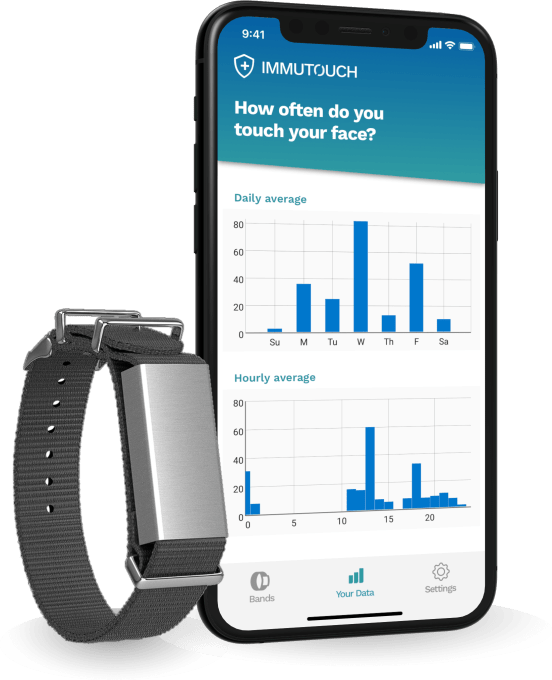
The goal is to develop a Pavlovian response whereby when you get the urge to touch your face, you don’t in order to avoid the buzzing sensation. Your brain internalizes the negative feedback of the vibration, training you with aversive conditioning to ignore the desire to scratch yourself.
“A problem the size of COVID-19 requires everyone to do their part, large or small,” says Slightly Robot co-founder Matthew Toles. “The three of us happened to be uniquely well equipped to tackle this one task and felt it was our duty to at least try.”
The Immutouch wristbands go on sale today for $50 each and they’re ready for immediate shipping. You can wear it on your dominant hand that you’re more likely to touch your face with, or get one for each arm to maximize the deterrent.
“We’re not looking to make money on this. We are selling each unit nearly at cost, accounting for cost of materials, fabrication, assembly, and handling” co-founder Justin Ith insists. Unlike a venture-backed startup beholden to generating returns for investors, Slightly Robot was funded through a small grant from the University of Washington in 2016 and bootstrapped since.

Slightly Robot and Immutouch co-founders (from left): Joseph Toles, Justin Ith, and Matthew Toles
“We built Immutouch because we knew we could do it quickly, therefore we had the obligation to. We all live in Seattle and we see our communities reacting to this outbreak with deep concern and fear” Slightly Robot co-founder Justin Ith tells me. “My father has an autoimmune disease that requires him to take immunosuppressant medication. Being in his late 60’s with a compromised immune system, I’m trying my best to keep the communities around him and my family clean and safe.”

How to calibrate the Immutouch wristband
Based on a study using wearable warning devices to deter sufferers of trichotillomania from ripping out their hair, Immutouch could potentially be effective. University Of Michigan researchers found the vibrations reduced long and short-term hair pulling. Ith admits you have to actually heed the warnings and not itch to instill the right habit, and it doesn’t work while you’re lying down. The Immutouch stops short of electrically shocking you like the older gadget called Pavlok that’s designed to help people quit smoking or opening Facebook.
Perhaps smartwatch makers like Apple could develop cheap or free apps to let users train themselves using hardware they already own. But until then, Ith hopes that Immutouch can gain some initial traction so “we can order larger quantities, reduce the price, and make it more accessible.”
Modern technologies like Twitter for rapidly sharing information could encourage people to take the right cautionary measures like 20-second handwashing to slow the spread of coronavirus. But having phones we constantly touch — before, during, and after we use the restroom — and then press against our faces could create a vector for infection absent from pandemics of past centuries. That’s why everyone needs to do their part to smooth out the spike of sickness so our health systems aren’t overrun.
Ith concludes, “Outbreaks like this remind us how we each individually affect the broader community and have a responsibility to not be carriers.”
Powered by WPeMatico
Facebook’s latest colonization of Instagram has begun. Facebook is testing the option to cross-post Stories to Instagram, instead of just vice-versa. Hopefully, that means the two apps will finally sync up the “already viewed” status of cross-posted Stories so we don’t have to watch re-runs any more, as I harped about in January.
If fully launched, the cross-posting feature could save social media managers and average users time while letting them maximize the views on the content they create. It could also give a little boost to the total Stories available on Instagram so its algorithm has more to choose from when ranking what it shows first.

But the change could also been seen as the most invasive injection of parent company Facebook’s identity into Instagram — which has been steadily increasing since Instagram’s co-founders left the company in late 2018 as their autonomy dwindled. Facebook has already pasted an “Instagram – From Facebook” title screen into the photo-sharing app’s boot-up phase, and added an Open Facebook button to its settings menu. Instagram added cross-posting of its Stories to Facebook in October 2017, allowing its parent to piggyback on the popularity of its ephemeral content.
Facebook Stories, Instagram Stories and WhatsApp Status all had 500 million daily users as of a year ago, while Snapchat as a whole has just 218 million users.
The screenshot of the Facebook-to-Instagram cross-posting feature was generated from the Facebook for Android app code by Jane Manchun Wong. She’s the renowned reverse engineering expert who has furnished TechCrunch with tips on dozens of unreleased features that went on to officially launch. When you’ve shot a Facebook Story and are about to post it, you can tap Privacy to review who you’re sharing with. In addition to the Public, Friends, Custom and Hide From options, Facebook is testing a Share To Instagram toggle that appears to turn on continuous cross-posting of that post and future ones.
A Facebook spokesperson tells me that the company is now formally testing the cross-posting feature to make it easier to share moments with the people who matter to you, as people might have different audiences and followers on Facebook versus Instagram. Facebook will continue to explore options for simplifying and improving how Stories work across its apps. That means it’s out of the internal-only prototyping phase and is now being tested with users in the wild.
With any luck, Facebook and Instagram will eventually sync up data about which Stories you’ve watched on either app, and avoid showing you exact copies of ones you’ve already seen. I made my case for this to Instagram’s leadership at a recent press dinner, noting how reruns waste hundreds of millions of people’s time and lead them to close Stories or the app altogether. I asked Facebook about that specifically; they declined to comment.
Creating two-way interoperability of Stories is a precursor to Facebook’s efforts to unify its Messenger, WhatsApp and Instagram Direct chat features. That could extend end-to-end encryption across the apps, protecting messages from prying eyes. But there’s been government grumbling about how encryption could hide the activity of criminals, and some see intertwining the chat features as a way to make it harder for regulators to break up Facebook.
Powered by WPeMatico
Meditation and mindfulness apps are booming. The top 10 apps pulled in $195 million in 2019, up 52% from the year before. Now, top meditation app Headspace’s former head of research, Nick Begley, is launching a new app that goes beyond mindfulness to specifically address the needs of those suffering from anxiety. The app, called Calmer You, offers a combination of activities, including not only guided meditation, but also journaling, cognitive behavioral therapy coursework and other health and wellness material.
The latter includes things like fitness videos, sleep stories and interviews with celebrities and inspirational people on their experiences with anxiety, among other things.
Begley worked for Headspace for two years, where he learned about the power of meditation apps to aid with self-development, he says.
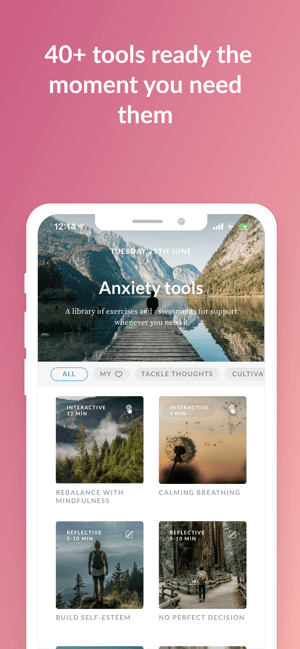 “I realized that it doesn’t have to be limited to just mindfulness,” explains Begley, as to how he got started with Calmer You. “There’s so much good advice out there, but just passively digesting it — watching videos or reading books — which is what most of us do when we want to improve, simply doesn’t deliver the changes that they promise,” Begley says.
“I realized that it doesn’t have to be limited to just mindfulness,” explains Begley, as to how he got started with Calmer You. “There’s so much good advice out there, but just passively digesting it — watching videos or reading books — which is what most of us do when we want to improve, simply doesn’t deliver the changes that they promise,” Begley says.
The problem isn’t that the advice isn’t good — it typically is. But people struggle with putting the advice into action, Begley says. That’s where Calmer You aims to help.
The app includes a few different components, including a 28-session course that helps guide you step-by-step to better understanding anxiety and helping to learn techniques to manage it. This includes cognitive-behavioral therapy, mindfulness, compassion-focused therapy, analytic techniques and more. In addition, there’s a toolkit with more than 50 quicker practices that are recommended based on how you’re feeling in a given moment or whatever situation you may be in. A journal for tracking how you feel day-by-day is available, as well.
Customers subscribe to the app for $7.99 per month or $47.99 per year.
“We didn’t specifically aim to fill the gaps of Headspace, but this is what users have mentioned,” Begley says. “A lot of people find it hard to regularly meditate, and so we wanted to provide tools and practices — in addition to mindfulness — to help people with anxiety. We wanted to provide a premium quality app experience that provides a more comprehensive approach to specifically helping manage anxiety and the many ways in which it manifests,” he adds.
Calmer You was developed in collaboration with anxiety expert and author Chloe Brotheridge, whose book “The Anxiety Solution: A Quieter Mind, a Calmer You” contributes to the app’s name. The team was familiar with Brotheridge’s book and reached out to her to see if she would be open to building an app based on her actionable advice.
This is a part of Calmer You’s parent company PSYT’s agenda — turning self-help books into apps.
The Calmer You team, via PSYT, also includes psychologists. But the app itself isn’t yet validated through things like randomized control trials, for example. That’s something they’d like to do further down the road, however.
Calmer You is also more geared toward women, as much of Brotheridge’s own work was particularly focused on anxiety’s impact on young women.
“For as long as I can remember, I’ve struggled with anxiety and I had to work out what worked best for me,” said Brotheridge. “This is why as a therapist, I teach people many different techniques so they can find what works best for them, not just mindfulness. While it took a lot of work to include multiple approaches in the app, I think it’s essential to help empower people to find the practices that work best for them and their situation,” she says.
Since the app’s launch into beta testing in November 2019, the company has been adding tools to respond to what users said they needed help with, including two new “rebalancing” tools (one for calming social anxiety, another to help communicate confidently), a worry journal for evening use and several more guided meditations and sleep stories.
The app shouldn’t be used instead of visiting a doctor for severe cases of anxiety, but could be slotted into a user’s routine if they’re already using a meditation app, like Headspace, to aid with feelings of anxiety on a regular basis.
Calmer You is a free download on iOS with a subscription business model.
Powered by WPeMatico
Spotify has been slowly rolling out a redesigned mobile app in small sections — first with an update to podcast pages, then to other parts of the experience. Today, the company is revamping the most critical part of the Spotify app: the home screen. Now, when Spotify users launch the app, they’ll notice the new home screen greets them depending on what time of day it is with a “Good Morning,” “Good Afternoon” or “Good Evening,” for example. But the screen’s content and recommendations will also change with the time of day, Spotify says, and the content has also been better organized so you more easily jump back in or browse recommendations from the main page.
Before, Spotify’s home screen emphasized your listening history by putting at the top of the page things like your “Recently Played,” “Your Top Podcasts” and “Your Heavy Rotation.”
Effectively, the update separates the app’s home screen into two main parts: familiar content on top and new or recommended content on the bottom half.
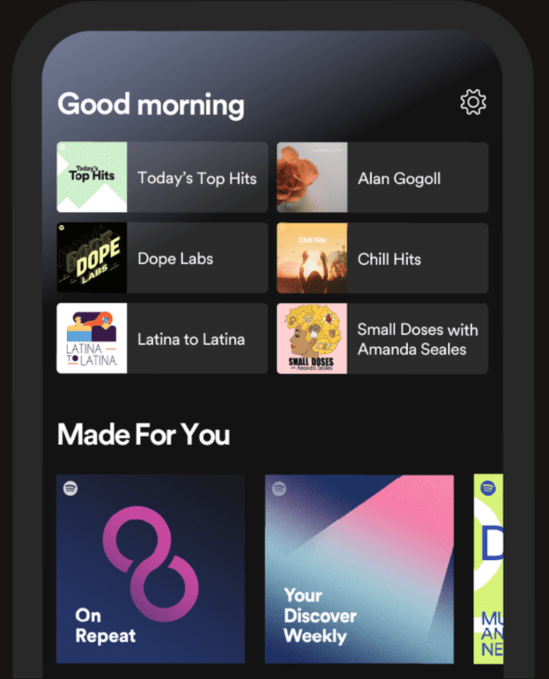 Now, the home screen reserves six spots underneath the daily greeting where you can continue with things like the podcast you stream every morning, your workout playlist or the album you’ve been listening to on heavy rotation this week. This content will update as your day progresses to better match your activities and interests, based on prior behavior.
Now, the home screen reserves six spots underneath the daily greeting where you can continue with things like the podcast you stream every morning, your workout playlist or the album you’ve been listening to on heavy rotation this week. This content will update as your day progresses to better match your activities and interests, based on prior behavior.
Beneath these six spots, the home page will display other things like your top podcasts, “made for you” playlists, recommendations for new discoveries based on your listening and more.
The concept for the new home screen is similar to what Pandora recently rolled out with its personalized “For You” tab late last year. Like Spotify, Pandora’s tab also customizes the content displayed based on the time of day, in addition to the day of the week and other predictions it can make about a customer’s mood or potential activity, based on prior listening data.
Pandora’s revamp led to double the number of users engaging with the personalized page, compared with the old Browse experience, it says. Spotify, too, is likely hoping to see a similar bump in usage and engagement, as users won’t have to dart around the app as much to find their favorite content or recommendations. That way, they’ll be able to start streaming more quickly after the app is launched, potentially leading to longer sessions and more discovery of new content.
Spotify to date has defined itself by its advanced personalization and recommendation technology, but its app hasn’t always been the easiest to use and navigate — especially in comparison to its top U.S. rival, Apple Music, which favors a simpler and cleaner look-and-feel. Its recent changes have tried to address this problem by making its various parts and pages easier to use.
Spotify says the updated home screen will roll out starting today to all global users with at least 30 days of listening history.
Powered by WPeMatico
TFLiving, looking to bring amenities to residential and commercial spaces, has today announced the close of a $4.8 million seed financing led by Camber Creek. Courtside Ventures, and other strategic investors, also participated in the round.
TFLiving uses technology to connect service providers, like massage therapists, yoga instructors and dog walkers, with property managers and their residents. The service allows residents to sign up for classes or services, as well as request other community events or services, directly from an app.
The most popular use case of the service is fitness, both classes and individual trainings, but TFLiving offers a relatively broad variety of services and experiences to residents at its 300 partnered properties.
Here’s how it works.
TFLiving signs partnerships with property managers of buildings that don’t currently offer amenities, or want to complement existing amenity offerings. After checking out the building, TFLiving determines if there is any under-utliized space in the building, such as a rooftop or a vacant unit, that could be repurposed for community classes.
After evaluating the space, TFLiving surveys residents and determines what they’re interested in via the app, which then serves up options from actual service providers on the service within the guidelines of the property manager’s financial guidelines.
One of the strengths of the business, according to founder and CEO Devin Wirt, is that the cost structure of the platform is highly customizable. Who pays is a question that can be answered by the property manager. If the building has a huge budget for community engagement and the property manager sees value in offering five classes/month and unlimited on-demand massage, they can choose to do so. The property manager can also grant TFLiving access to the building without paying a dime, passing on the full cost of the service to residents.
In most cases, property managers will foot the bill for community events, while residents pay for their own individual services like massage and dog walking.
Because TFLiving’s pricing is based on service and not calculated by number of units, the product can be priced at an affordable cost within the budget of the property and based on demand from the residents.
TFLiving also allows property managers to mark up the class or service and keep a cut of the profit. For example, if a property manager doesn’t have the budget for community classes or services, but doesn’t mind letting residents book individual personal training in the on-site gym, that property manager can mark up the cost of fitness classes by 20% and generate some revenue that could eventually go toward community events.
“One of the things that we stay pretty stringent on is just how far they’re able to market the prices,” said Wirt. “As a core mission of staying affordable to all asset classes, we understand that because we’re not paying a lease, we’re able to charge below market pricing. We still want to stay true to our core mission that we want to provide affordable services.”
Unlike ClassPass, which also connects service providers to users in the fitness space, TFLiving does not dynamically price its various classes and services based on popularity or quality. Fitness classes, for example, are always between $50 and $80, with geography being the main determining factor on specific price.
The company declined to share the revenue breakdown between the company and service providers, but noted that it varies by vertical and that service providers receive a majority of the revenue.
TFLiving currently has agreements with properties across 29 states, with contracts at more than 800 properties, soon covering more than 200,000 units.
Wirt says that he sees the potential to implement TFLiving in commercial spaces as well, such as offices.
Moreover, TFLiving has worked on the tech side to be as useful, not necessarily as prominent, as possible. TFLiving integrates with a variety of property management platforms, from mobile doorman apps to platforms for paying rent to maintenance requests. Residents using those apps can request and book TFLiving amenities straight from those platforms.
Powered by WPeMatico
ZenGo is expanding beyond the basic features of a cryptocurrency wallet — letting you hold, send and receive crypto assets. You can now set aside some of your crypto assets to earn interests. In other words, ZenGo now also acts like a savings account.
The company has partnered with two DeFi projects for the new feature. DeFi means “decentralized finance”, and it has been a hot trend in the cryptocurrency space. DeFi projects are the blockchain equivalent of traditional financial products. For instance, you can lend and borrow money, invest in derivative assets and more.
If you want to learn more about DeFi, here’s an article I wrote on the subject:
But let’s come back to ZenGo. When you have crypto assets in your ZenGo wallet, you can now open the savings tab, pick an asset, such as Dai, and select what percentage of your holdings you want to set aside.
After that, all you have to do is wait. You get an overview of your savings “accounts” at any time. This way, you can see your total earned interests. Interests are automatically reinvested over time. You can move your money from those DeFi projects back to your wallet whenever you want.
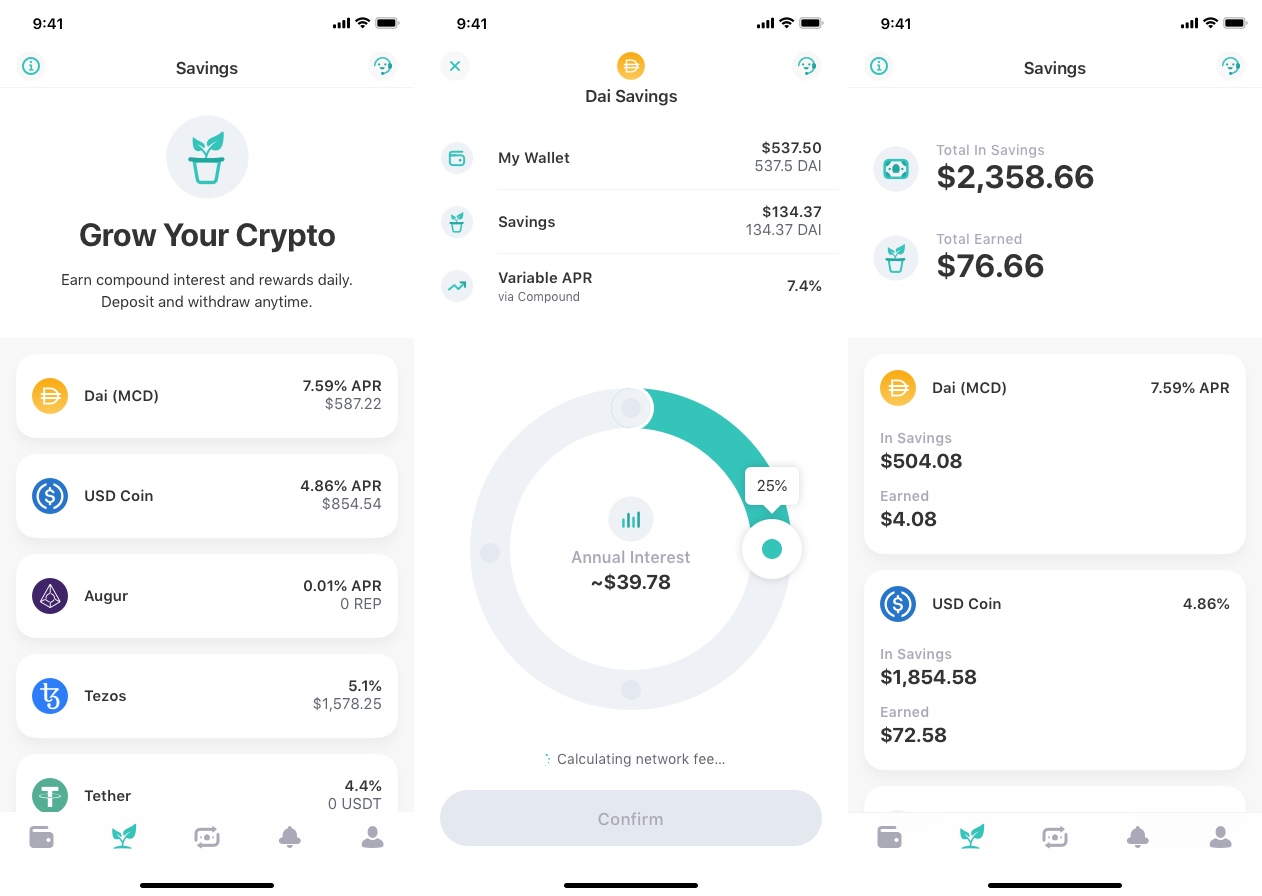
Behind the scene, ZenGo uses the Compound protocol, a lending DeFi project. It works a bit like LendingClub, but on the blockchain. Some users send money to Compound to contribute to liquidity pools. Other users borrow money from that pool.
Interest rates go up and down depending on supply and demand. That’s why you currently earn more interests when you inject DAI or USD Coin in Compound. But that could change over time.
ZenGo also uses Figment in order to stake Tezos. This time, it isn’t a lending marketplace. When you lock some money in a staking project, it means that you support the operations of a particular blockchain. Few blockchains support staking as they need to be based on proof-of-stake.
For the end user, it looks like a savings account whether you’re relying on Compound or Figment. There are other wallet apps that let you access DeFi projects, such as Coinbase Wallet and Argent. But ZenGo thinks they’re still too complicated for regular users.
Powered by WPeMatico